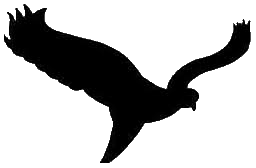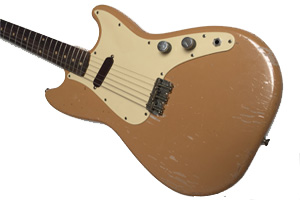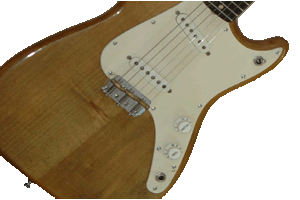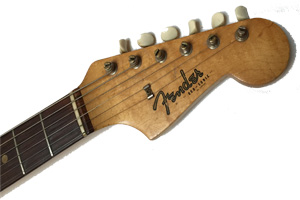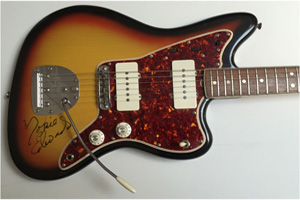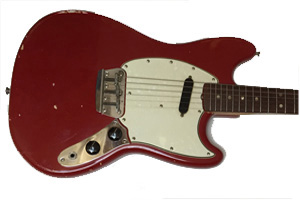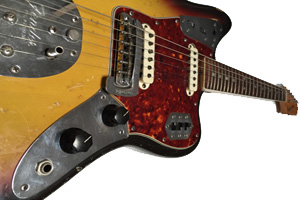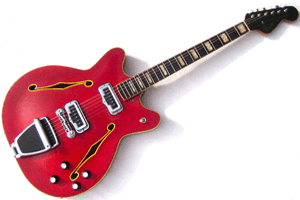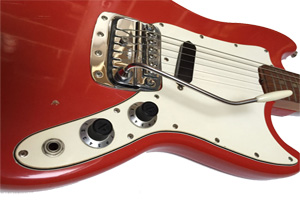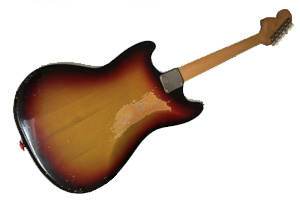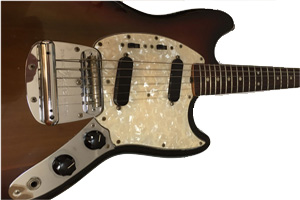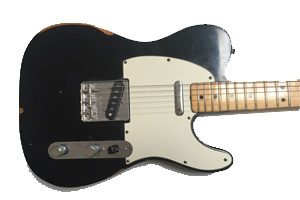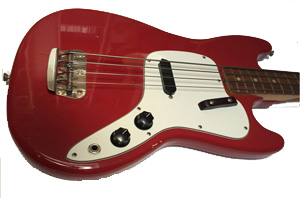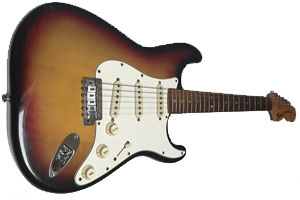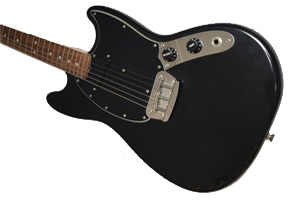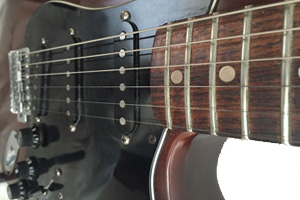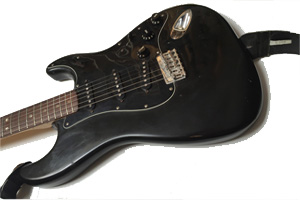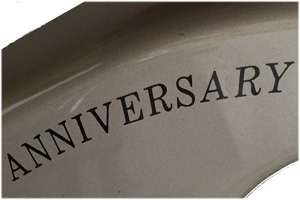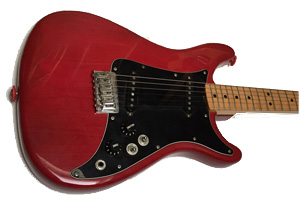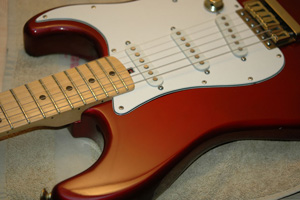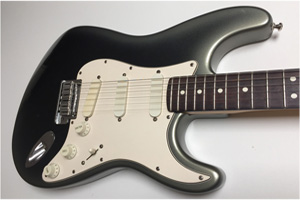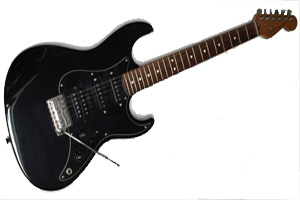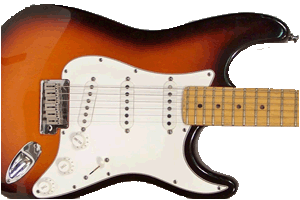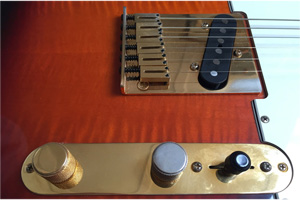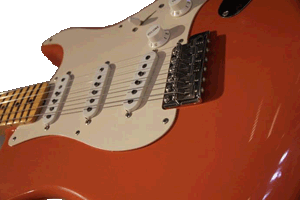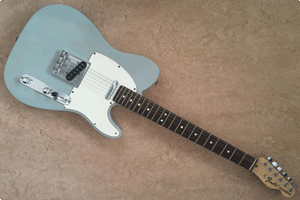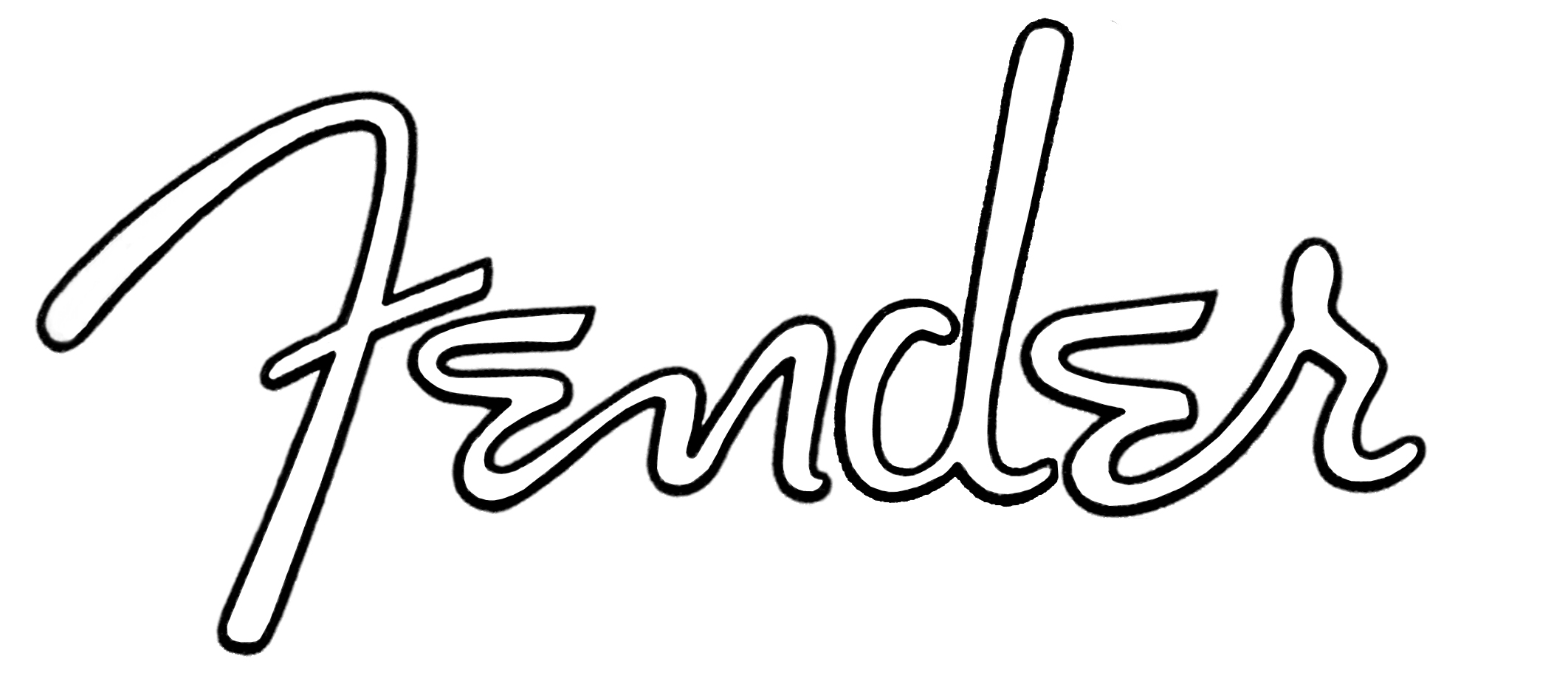 Fender, where my collection actually started unnoticed. After a rickety acoustic guitar and an affordable Japanese Telecaster clone (from the Jedson brand), something better was needed. I was told at the time that a Fender of Gibson was made for the serious work. Also according to record covers and during live performances, the heroes played on such instruments, the choice was therefore determined. Without any hindrance from knowledge, I had decided to become a Stratocaster. At the end of December 1978 I took the train to The Hague to buy a black Stratocaster (rosewood fingerboard, was slightly cheaper). Once I started playing the instrument, a few things struck me. The three-point fastening of the neck was such that the neck would occasionally shift slightly. As a handy do-it-yourselfer, there is only a four-point plate screwed on. The machine heads did not always get the guitar to tune easily, and once tuned the Strat would sometimes get out of tune. A set of Shallers and the tuning problem was solved. The hum diminished after I shielded the wiring and mounted a metal pickguard (handcrafted, still made with a jigsaw). Furthermore, another volume potentiometer and I had the illusion that this Blacky had been transformed into a top instrument. Maybe that was the case, this Stratocaster has bravely assisted me for many years. In hindsight, of course, the well-intentioned modifications were not conducive to value development.
Fender, where my collection actually started unnoticed. After a rickety acoustic guitar and an affordable Japanese Telecaster clone (from the Jedson brand), something better was needed. I was told at the time that a Fender of Gibson was made for the serious work. Also according to record covers and during live performances, the heroes played on such instruments, the choice was therefore determined. Without any hindrance from knowledge, I had decided to become a Stratocaster. At the end of December 1978 I took the train to The Hague to buy a black Stratocaster (rosewood fingerboard, was slightly cheaper). Once I started playing the instrument, a few things struck me. The three-point fastening of the neck was such that the neck would occasionally shift slightly. As a handy do-it-yourselfer, there is only a four-point plate screwed on. The machine heads did not always get the guitar to tune easily, and once tuned the Strat would sometimes get out of tune. A set of Shallers and the tuning problem was solved. The hum diminished after I shielded the wiring and mounted a metal pickguard (handcrafted, still made with a jigsaw). Furthermore, another volume potentiometer and I had the illusion that this Blacky had been transformed into a top instrument. Maybe that was the case, this Stratocaster has bravely assisted me for many years. In hindsight, of course, the well-intentioned modifications were not conducive to value development.
A few years later a 2nd hand Telecaster (1973) and then a used Stratocaster (1974) were added. Why Fenders? I think it was a matter of getting used to it. For example, when I got a Gibson in my hands, it felt "awkward". Moreover, with the screwed necks and the electronics mounted on one plate, you could easily "tinker". Fenders always remain interesting to collect and especially to play on. However, over the years I have received more and more appreciation and attention for other brands. See, for example, the various copies on this site.
The so-called pre-CBS copies are usually seen as the "real" Fender collectibles, so built up to and including 1964. Unfortunately, "almost unaffordable" (for me) if you want a good and original instrument. Partly for that reason I prefer the first few years from 1965. Reasonably priced and otherwise more or less comparable. About the 70s Fenders is often done negatively. But especially among the specimens from the first half of the 70-ers you can find nice objects.
Fender Champion - 1953
 A 6-string lap steel and therefore also fine to use on your lap with a slide by an "average guitarist". The layer / color with which the body is finished is also called mocking MOTS (Mother Of Toilet Seat). Made from 1949 and succeeded in 1955 by the Fender Champ lap steel
A 6-string lap steel and therefore also fine to use on your lap with a slide by an "average guitarist". The layer / color with which the body is finished is also called mocking MOTS (Mother Of Toilet Seat). Made from 1949 and succeeded in 1955 by the Fender Champ lap steel
This Champion is still equipped with the original "single coil" cartridge, similar to what was used in Telecasters at the time. The potentiometers have been replaced over the years. Everything else is original.
In general, such lap steels are tuned into a chord like an open A, D, E, or G.
Fender MusicMaster - 1960
In the well-known color "Tan / Desert sand" (was there actually a different shade then?). The neck is from 7-60 (July).
It is noteworthy that the serial number is on the bottom of the metal neck plate, something that you often encounter with 59-and-60 Fenders (stamped on the bottom of the plate).
It is also claimed that the so-called L-serial numbers (which appeared a few years later) were a mistake because the "L" should actually have been the number "1", but was mistaken as a letter. The numbered neck plates do not seem to have been used in a logical order over time either. They had a "tray" from which a random picture was always taken.
Fender Duo Sonic - 1961
An original, but a repainted body. The neck (1-1961) has a new logo because the original had almost perished. The elements and potentiometers come from other Fenders from a later period and are therefore not original.
A Frankenstein guitar with an original body, pickguard, switch, machine heads and neck.
Fender Duo Sonic - 1962
The neck date indicates '62.
The switch has been replaced by an original copy from a Duo Sonic from 1959 (you should happen to know because the difference is not visible).
The Duo Sonic, just like the Musicmaster of that time, has a shorter scale / neck.
Fender Jazzmaster - 1965
A version with a neck that has a combination of white bindings and dots. This version has only been on the market for a short time and is considered the transition type between the version with dots (without bindings) and the later version with the blocks on the neck (and with bindings). The neck date indicates OCT 1965 and the serial number is one from the so-called L-series.
The signature on the body is by the way by Nokie Edwards (The Ventures). This sunburst Jazzmaster was used during a European tour of Nokie Edwards in 2002, where the Dutch formation Adventure formed the backing band. Via the previous owners (known to me) I ended up after some research with the guitarist who played during the tour and finally had this Jazzmaster signed by Nokie. Not a very big added value for me, but maybe a fan thinks otherwise. Actually a bit of a unique "Fender Jazzmaster Nokie Edwards Signature". Unfortunately, on March 12, 2018, Nokie passed away from complications after hip surgery.
Fender Musicmaster II - 1966
This one is equipped in the color "Dakota Red".
Unlike its predecessors from an earlier period, the Musicmaster II has a longer neck / shell (24 inches instead of 22.5 inches).
On the neck is the designation JAN 66 B.
Fender Jaguar - 1966
A sunburst Jaguar with APR 66 as the neck date. A neck with bindings and dots, as standard in that year. The front and back of the body clearly show the traces of years of use.
As with most Jaguars, the "unusable" rubber damper is missing from the bridge. Everything else is original.
The Jaguar that made its debut in 1962 was intended as a top model and was a kind of further development of the Jazzmaster. However, it did not become as popular as the (at the time cheaper) Telecaster and Stratocaster. The neck with its 24-inch length was shorter than most other Fenders (25.5-inch).
Fender Coronado II - 1967
A semi-acoustic Fender in the color Candy Apple Red. The neck indicates 19 APR 67 B. This Coronado has the addition "II" meaning the two element version (Fender made by DeArmond). There was also a Coronado I with a single element and a Coronado XII with the twelve string version, which was also equipped with two elements.
This copy is equipped with an then optional "tremolo".
The pickguard was missing when purchased. After some searching I finally got an original copy from the same year in America.
Fender Bronco - 1967
One of the first Broncos (on the 24-inch neck the date is 16-10-1967). The Bronco's body is the same as the Mustang's. The color is Fiesta Red (I think there was only a standard color at the time) and the instrument is still neatly painted. Has one element and the date is 1-11-1967.
The "tremolo", with a different construction for Fender, on this copy still works fine.
Fender Mustang - 1972
A sunburst Mustang with the birth certificate: SEPT 72 B. The potentiometers refer to week 39 in the year '72.
Both elements were once replaced by other copies. Similar Mustang elements have now been found and placed again.
According to the back of the body, one of the previous owners liked to have a belt with a metal buckle.
Fender Mustang - 1973
Another sunburst Mustang, but now a year younger. You can clearly see through the transparent varnish that the body consists of several glued parts.
The neck indicates that it was made on week 4 on day 4 (Wednesday) in 1973.
The potentiometers refer to week 14 in the same year.
Fender Telecaster - 1973
A black (then a custom color) Telecaster from 1973. This instrument has been in my possession since 1981. The neck states: 3 MAR 1973 (the 3 is not the date, however, but refers to the type of neck). The potentiometers indicate week 47 in '72.
A thin and narrow neck and a lightweight body. In the "known places" the paint has worn off over time.
Unfortunately the neck element broke down in March 2015 and was then replaced by a "Custom shop Texas special". The sudden death of an element is something that you often encounter with old Fenders and has to do with the windings that have direct contact with the magnets. I kept the original "dead" element. Immediately during that action, part of the wiring was replaced. Everything else is as the guitar once left the factory.
Fender Musicmaster bass - 1973
A "short scale" (30 "scale) bass intended as an entry level model, in the color Dakota Red. The volume potentiometer refers to week 10 in 73, and the element also has '73 as an indication.
The support for the fingers in this version is still "under" the strings. Later versions have a thumb rest on the other side of the strings.
The pickup for these 4-string basses also has 6 separate magnets. The reason for this is that the pickup that was used was actually designed for the 6-string Mustang, Musicmaster or Duo Sonic guitar.
These 4-string Musicmasters were produced from 1970 through 1983.
Fender Stratocaster - 1973
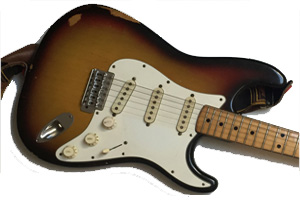 Potentiometers from week 37 in 1973. A special feature is that so-called black-bottom elements are used in this Stratocaster (as only for a short period that year). See the various "discussions" on the internet in which one wonders the reason / background of this, old parts perhaps that had to be?
Potentiometers from week 37 in 1973. A special feature is that so-called black-bottom elements are used in this Stratocaster (as only for a short period that year). See the various "discussions" on the internet in which one wonders the reason / background of this, old parts perhaps that had to be?
The Strat is original, except for the replacement of the 3-position switch in a 5-position version, and another plastic volume knob.
The body and the maple neck clearly show signs of use.
Fender Stratocaster - 1974
For a Strat over 40 years old, it is in beautiful condition. The volume potentiometer has been renewed and the wiring has been replaced by shielded cables. Everything else is original.
The numbers on the elements indicate 74 as the last digits and the pots indicate week 31 in that year.
Features a pleasantly playable neck with rosewood fingerboard.
Fender Musicmaster - 1977
A beautiful black copy that is still almost indistinguishable from "new".
The maple wood of the neck shows a beautiful pattern.
The accompanying Fender booklet with a sticker with the same serial number and the original case are still included.
Fender Stratocaster - 1977
In the color Mocha Brown and with a rosewood neck.
Someone once provided aluminum foil behind the pickguard, and the neck was reborn. Furthermore, everything is original after the original bridge has been replaced.
Like most Fenders of the time, the instrument is somewhat heavy.
Fender Stratocaster - 1978
According to the serial number S90xxx, you might think it is a '79 -er. But given the fact that I bought this Blacky myself on December 23 '78, I know the year of construction. It is perhaps remarkable that this is a version without "tremolo". The 3-point mounting has now been replaced by a 4-point, the wiring has been renewed, the bridge element has made way for a copy of Lindy Fralin. Shaller machine heads and a white plastic completed the "adjustments" at the time.
The original black pickguard and the original machine heads have now been restored.
The neck feels quite thick and the instrument is "quite heavy".
The purchase receipt is above water again. December 1978. "Servaas music trade" in The Hague, Fl 1215, - at the time, including the "original" suitcase of 145, - Gulden.
Fender Stratocaster 25th Anniversary - 1979
A completely original 25th Anniversary in near mint condition. Unfortunately, the corresponding numbered certificate is missing. This model was Fender's first anniversary model.
Originally they were first available in white, but that lacquer cracked and even loosened locally. After about 500 copies they switched to silver paint, but it quickly discolored in a kind of green shade. Then they switched to silver paint from Porsche, which remained the same color. This anniversary comes from the last series and is still beautiful in color.
A total of 10,000 were made, each copy is numbered on the neck plate.
Noteworthy compared to the "regular" Stratocasters from that period are the 4-point fastening of the neck and adjustment of the neck pin on the side of the body (as with the first generations). And for the first time, such Sperzel machine heads were used in a Fender.
Fender Lead II - 1980
Actually a bit of an economical competitor of a Stratocaster from that time (however 2 single coil elements and no "tremolo"). The elements are of the type called "X-1" and were also standard in "The Strat" during that time.
The neck is almost identical, the body is slightly smaller / lighter than the Stratocaster.
Built at the Fender factory in Fullerton, California from 1979 -82. An underestimated instrument that can still be obtained reasonably well and affordably. This red Lead II has a maple neck, but a rosewood fingerboard was also an option at the time.
40 years later, Fender released a reissue of the Lead II and III guitars.
Fender The Strat - 1980
A Strat (without ... ocaster). The first limited edition of Fender since the 25th anniversary. Back to the 4-point attachment and a smaller head (matching color) and a clumsy neck adjustment on the side of the body.
In the place where a "normal" Stratocaster has a tone control, there is a rotary switch with which, in combination with the 5-position element switch, a total of 9 different sounds can be selected (elements in series / parallel, etc.). The pickups have a bit more power than the usual Stratocasters of that time and were called "X-1" by Fender.
The hardware is gold plated (22 carat), but to get the guitar on the market as soon as possible, one did not wait until the gold plated machine heads were available. The first series (to which this belongs) of "The Strat" has standard chrome-plated machine heads and a plastic "button" on the switch. In the later copies these parts were also gilded.
The colors available were initially Candy Apple Red, Lake Placid Blue and Artic White. Later a Walnut version with a black pickguard was added. My Candy Apple Red copy is original, except for a small recess in the pickguard at the level of the neck. According to the stories, the "The Strat" prestige project did not really yield anything, Fender even had to settle on every copy sold.
Fender Strat Plus - 1989
In a color called Black Pearl Dust. According to the information on the neck, this is from AUG 1989. The strings go through a recess in the special nut, the so-called "Wilkinson needle-bearing roller nut". The machine heads are of the "Locking Tuners" type and can be from Shaller (at my Strat) or Sperzel.
The elements are of the "Gold Lace Sensor" type with closed caps so that the magnets are not visible. The element at the bridge of my copy has now been replaced by an original copy from that time. In fact, everything is now original again.
The Strat Plus is equipped with a so-called TBX control (Treble Bass eXpander). With the second tone control, both the high and low tones could be boosted or cut. With the traditional Stratocaster's standard tone controls, it was only possible to attenuate the high frequencies.
Many of this series were standard equipped with a so-called Hipshot Tremsetter. In the recess on the back of the body was behind the plastic plate a kind of spring that reminds me a bit of a shock absorber. This was to ensure that the bridge was put back in the correct position after using the "tremolo". For example, the risk of detuning the instrument when enthusiastically using the "lever" had to be avoided.
The Plus was introduced in 1987 and built until early 1999. In addition to the Plus, a Plus De Luxe and an Ultra also appeared.
Fender Prodigy - 1991
This Stratocaster-style model with a humbucker near the bridge was to become an affordable alternative in an attempt to compete. The body has the shape of a Stratocaster, but with less rounded edges. The guitar, which was only available on the market for about 2 years, is marked "made in USA". However, this applied to the location of the assembly and not to the place where the parts were made. A convenient way to keep it affordable.
The neck is pleasantly playable and the sound is very usable. Since the connection of the plug is located on the plastic pickguard, this plate wanted to burst with excessive use. My copy is also affected.
Fender Stratocaster - 1995
This two-tone sunburst Stratocaster from '95 with "water damage" on the neck, I had purchased inexpensively with the initial intention to conduct various experiments with it. Afterwards, the wood of the neck was still in good condition, only the paint and frets were "affected". The bridge element was once replaced by another Fender copy.
After a facelift, it turned out to be a great guitar that should not be used for (further) experiments.
Fender Telecaster 50th Anniversary - 1996
Built in a limited edition of 1250 copies. Actually a Custom Shop product (although this is not mentioned) with a "flame maple top" and gold-plated hardware. At the back of the head is a so-called "anniversary coin" and the neck plate has a unique serial number in the series of the 1250 that are made in total. Equipped with so-called "vintage voiced pickups". This is number 1001 of the limited series.
My Tele has lost quite a bit of the gold layer on the record near the potentiometers and on the volume knob, but is otherwise in excellent and still original condition.
Fender Stratocaster Custom Shop California Beach - 2004
A Custom Shop guitar in the color "Coral Sunset" (also called "Sunset Orange"), a kind of pastel orange. The guitar was built especially for a European music fair in a numbered edition of 150 copies in total. This version was not officially sold outside Europe.
The redition is based on a '57-er Stratocaster. However, the neck radius is 9.5 "and the pickups are of the" Fat 50s "type. Fortunately, a 5-position switch was chosen.
The (nitro lacquer) maple neck indicates: MAR 08 2004.
The serial number shows that it belongs to the first few copies. After a necessary adjustment it is really a great instrument
Fender Telecaster 2007
Purchased for my daughter. She had taught herself to play guitar on a (mine) borrowed Gibson Marauder and had been dreaming of her own blue USA Fender Telecaster for a while. The instrument is now known as "Sugar" (Sugar Blue).
The blue lacquer is transparent, so you can see the grain of the wood through it.
Since October 2019, the tele has moved to Catelonia, where the owner has been living for a few years now.
